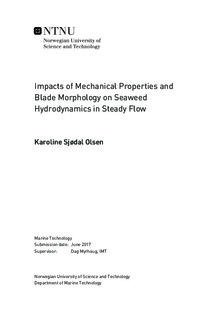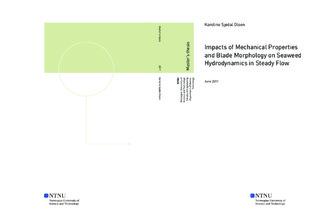| dc.description.abstract | Global environmental changes are a well known phenomenon affecting the climate around us. The challenges the world face in the coming 30 years regarding food production, climate change and adaption to new environments will have a tremendous impact on the way we live. The interactions between aquatic biological systems and their physical environment can help increase the information on different aspects of these changes. The complexity of the aquatic systems help with absorption of carbon dioxide, wave damping at exposed shores and as a future food source. All of these advantages can help to diminish these changes in a sustainable way. Expanding the knowledge around these subjects will increase the probability of solving the coming challenges.
In this thesis the aspect of plant-flow interactions is investigated. Surrogate plant models with different materials and simplified plant shape were used to mimic real plant behaviour exposed to fluid flow. Drag forces on the plant surrogate are also tested experimentally. A laboratory flume tank was used for the model tests. In order to understand the flow behaviour several preliminary experimental tests were performed to map the flow conditions. Flume floor measurements, velocity tests, water elevation tests and head loss were investigated. Acoustic Doppler Velocimetry was used to observe the velocity profiles occurring in the flow both in vertical direction and across the cross-sections of the flume. The velocities were recorded at velocity 0.34 m/s. Measurements were recorded from point 423 cm to 1400 cm. The vertical velocity profiles from point 1023 cm indicated inaccuracies at the top half of the water column. These inaccuracies can occur from eddies in the flow creating second-order effects disturbing the profile. The cross-sectional profiles indicated an inaccuracy at point 1023 cm, but showed an improvement further down the flow at point 1400 cm. This inaccuracy can be caused by second-order current by changes of the flume floor throughout the flume. The velocity profile were also compared to previous velocity profiles obtained from the preliminary testing in Fall 2016. The turbulent Reynolds stresses were mapped at these points, and the findings undermined the assumption of second-order effects. The surrogate models were made using a plexiglass mould of a simplified shape of the kelp Laminaria Digitata. Three models were made in three different silicone materials ranging in shore hardness from 20A-90A.
The plant models were tested with five different velocities from 0.05 m/s to 0.34 m/s to observe plant-flow interactions and drag forces. The plant model surrogate 60A was the only one investigated regarding drag forces, because it was the surrogate model without air bobbles and holes in the silicone structure. The plant-flow interaction were recorded with cameras at different points outside the flume. The results of the plant-flow interaction tests indicated different behaviour for the surrogate models. Surrogate 20A, the most flexible model, streamlined for the lowest velocity of 0.05 m/s and the stiffest model surrogate 90A only streamlined at the highest velocity of 0.34 m/s. Surrogate 20A was also the only model significantly moving crosswise in the flume, which can possibly be linked to the second-order currents. From the videos recorded of the model oscillating frequencies of the plant stems were observed. The frequencies observed seemed to converge towards a similar value around 1.5 Hz. This is unfamiliar behaviour, and may be an indication of the lock-in effect of vortex-induced vibration. The vortex shedding frequencies were plotted against the frequencies of the plant models, but the plot did not indicate a lock-in effect. Therefore, a suggestion that the blade of the plant may be the dominating factor was proposed. The undulating of the blade creates forces that cause the stem to oscillate, and it is therefore maybe not affected by vortex-induced vibration. This argument will need further analysis to be confirmed. The drag forces were inside a reasonable range expected by such a plant model shape, but did not follow the rule of increasing linearly with velocity squared. This is maybe caused by the Reynolds number not being significantly high. In conclusion, plant-flow interactions are complex processes that needs further investigations to confirm the finding from such experimental research as this. The model tests indicated that all the models streamlined as a way to minimise drag forces in the flow. This is confirmed by previous studies. The oscillations of the stem may be dependent on the blade motions. The behaviour of the plant models are affected by changes caused by second-order effects in the flow, especially the most flexible plant model. Further research is needed on plant-flow interactions to confirm the finding in this thesis. | |

